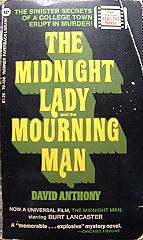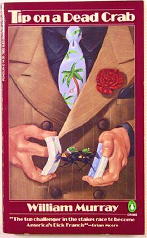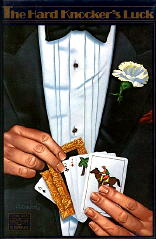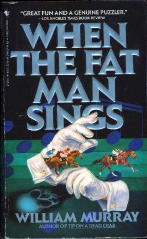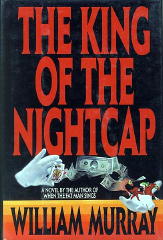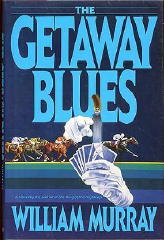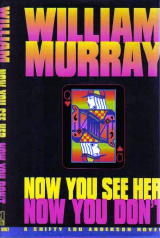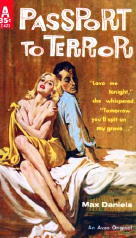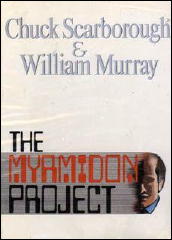April 2009
Monthly Archive
Thu 30 Apr 2009
CAPTAIN THUNDER. Warner Brothers, 1930. Fay Wray, Victor Varconi, Charles Judels, Robert Elliott, Don Alvarado, Robert Emmett Keane. Director: Alan Crosland.
It was “Captain’s Day” one day last week on TCM. This one followed Captain Applejack which I watched and commented on a couple of days ago, with several more taped and ready to be watched as soon as I’m able, including Captain Blood, which is first movie I remember watching as a kid, when I was perhaps six or seven years old.
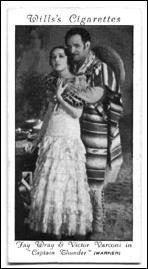
Many of the other movies in this grouping, which were shown all day, seem to have been newly recovered from the vaults, but if so, this one may as well go back in. It does feature Fay Wray, whom I can watch in anything, as this movie has proven, but it has little else going for it that would prompt more than the slightest recommendation.
Not only does Fay Wray have a leading role, but the very first time we see her, she’s in a very skimpy slip and little else, a fact worth both pointing out and explaining.
Captain Thunder, a Mexican bandit raising havoc with the forces of the utterly inept and totally comical El Commandante Ruiz (Charles Judels), has previously robbed the stagecoach in which she was coming into town, and part of the tribute demanded was the outer clothing of all its passengers. (And perhaps the driver and the fellow riding shotgun as well. I should go back and look. I was distracted at the time.)
El Capitan Thunder is played most boisterously by Victor Varconi, a Hungarian playing a Mexican in this movie. His career began in the silents back in his homeland, starting in 1913, and as is often the case with many early talking films, some actors did not at first understand that less is sometimes more.
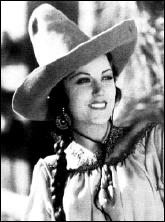
Be that as it may, Captain Thunder’s credo is that he will keep all of the promises he makes, which puts him in a quandary when one he makes to the slim and supremely beautiful Ynez Dominguez (Fay Wray) runs headlong into one he makes to the evil Pete Morgan (Robert Elliott), a strutting gent with eyes on Ynez himself, although she is about to marry another. Much booing and hissing expected here.
Fay Wray’s career survived this pre-King Kong film, I’m happy to say, and surprisingly enough, so did Victor Varconi’s, who had many small parts and supporting roles through the early 1950s. Director Alan Crosland died in 1936 at the age of only 41, but before that, he was at the helm of a couple of Perry Mason movies, and The White Cockatoo (1935), a film based on a pretty good mystery novel by Mignon G. Eberhart.
Thu 30 Apr 2009
Posted by Steve under
Authors[4] Comments
Introduction: David Hume was the primary pen name of J(ohn) V(ictor) Turner, 1900-1945, an English author of several dozen mystery and detective novels not only under his own name and as Hume, but also as Nicholas Brady.
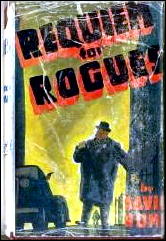
He has come up for discussion several times on this blog, the first being this review I wrote of Requiem for Rogues. This post also contains a complete bibliography for Mr. Turner, taken from Al Hubin’s Crime Fiction IV.
This followup post discusses several of Mr. Turner’s many series characters as well as a little more about his life, accumulated from several sources, including a portrait of him taken from the back cover of one of his books.
One additional post included more on Mr. Turner, with quite a bit of information provided by Bill Pronzini. Also announced was the creation of a webpage to display the covers of many of Mr. Turner’s books, found here.
These posts are all two years old, so by all means go back and (re)read them before continuing. Last Monday, I received an email from Judith Gavin, who said “John Victor Turner, was the middle of the three brothers, in a family of six children. My Grandmother was married to the oldest brother.” She also provided me with several paragraphs of information about Mr. Turner, aka David Hume.
Since some of what she included in her first email was perhaps not sufficiently verified to be placed online, Judith has kindly rewritten it and has agreed to allow me to post the following in its stead:
John Victor Turner was one of six children, and the second of three boys in a family who moved to Stone in Staffordshire, having previously lived in the Wythenshaw area of Manchester. (There seems to be no record of why the family moved from Manchester to Stone.)
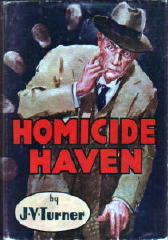
The three Turner boys were Alfred, John (but the family usually referred to him as Jack as much as they called him John, the two names were interchangeable most of the time) and the youngest son was Joseph Turner, Joe to all the family.
Alfred, the eldest son went to the War front on his 16th birthday and although he survived he was devastated by shell shock, the shadows of which gripped him throughout his life leaving him unable to hold down regular employment and making drink a constant companion.
The second son, writer John Victor, would have been 16 in 1916 (his service years and regiment have yet to be confirmed). He secured employment on a local paper in Warwick (or it may be Stoke, to be confirmed) then several years later travelled to work in London as crime reporter on The Daily Herald Newspaper in Fleet Street where it is true that he was known for his network of associates, his contacts in the criminal underworld going regularly to live along side them.
It is probable, however, that few of his underworld contacts knew that he had a younger brother, Joseph, who had also travelled to live and work in London – as a police officer, eventually rising to a senior rank in Scotland Yard.
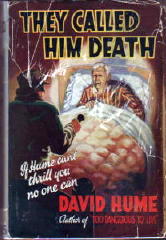
John Victor (Jack) married twice. His first wife, with whom he had a daughter, died when she drowned in the canal in Stone,
(Details of names of first wife etc to follow when clarified further.) It was many years later when he married again, to a woman believed to be originally from Scotland, and they had a son. (Again details of name etc to follow when clarified further.)
The timing of JV Turner’s death in 1945 may have caused some to speculate that he may have sustained injuries in the Second World War. This was not the case. The cause of death has always been rather glossed over as something of a mystery in the family, not because it was thought to be sinister or suspicious, or heroic, but because it may have been linked to TB which was “hushed up” by the family partly because it was notifiable and contagious, but also as it was associated with poor living conditions etc.
The above information was supplied by my mother, Mrs Ann Hume Gregory (Nee Turner), daughter of Flora May Turner, (Nee Tully) who was married to the eldest Turner son, Alfred, before they separated in 1950. Flora May Turner (Nee Tulley) was also a first cousin to the Turner brothers.
Wed 29 Apr 2009
REVIEWED BY WALTER ALBERT:
SUPER-SLEUTH. RKO Radio Pictures, 1937. Jack Oakie, Ann Sothern, Eduardo Ciannelli, Alan Bruce, Edgar Kennedy, Joan Woodbury. Director: Benjamin Stoloff. Shown at Cinevent 20, Columbus OH, May 1988.
Jack Oakie plays a popular film sleuth who tries to repeat his success on screen in an off-screen mystery, abetted by studio publicist Ann Sothern (trying to cover up his almost constant mishandling of his amateur sleuthing).
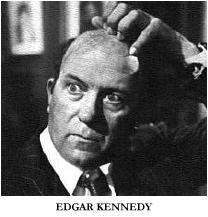
Edgar Kennedy was good as James Gleason’s flat-footed assistant in the delightful Murder on the Blackboard, the second of the Hildegarde Withers/Inspector Piper collaborations with Edna Mae Oliver (1934), shown earlier in the day, but he was even better in Super-Sleuth.
For once, Kennedy comes off as a sympathetic, even competent professional undone by an incompetent amateur, even though the bumbling “Edgar” character lurks somewhere not too far from the surface.
The heavy is Eduardo Cianelli, the unforgettable “assassin” of Gunga Din, and the comic/suspenseful climax has a wax museum as the perfect setting for the conclusion of a film about on- and off-screen detecting.
– From The MYSTERY FANcier, Vol. 10, No. 3, Summer 1988, mildly revised.
[EDITORIAL COMMENT.] My usual sources have come up dry as far as finding suitable images to show you. Even more unexpectedly, the movie itself has proven to be elusive, although not impossible to find in the usual collector-to-collector markets. The photo of Edgar Kennedy, a standard publicity shot, source unknown, is not from Super-Sleuth, or at least I’m fairly sure it’s not. — Steve
Wed 29 Apr 2009
DAVID ANTHONY – The Organization. Coward McCann, hardcover, 1970. Paperback reprint: Pocket, 1972.
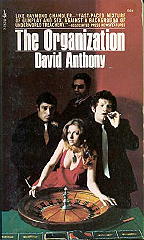
David Anthony’s Stud Game (reviewed by Steve Lewis in the previous post) was nominated for an Edgar as best paperback mystery of 1978. The Organization is an earlier episode in the life of the same main character, professional gambler and part-time private eye Stanley Bass.
And it’s quite an episode. While reading it I was reminded very much of the 1950s paperbacks of Charles Williams, the ones in which a man becomes involved with a woman who in one way or another gets him into a situation from which there seems to be no escape.
I don’t make this comparison to Williams lightly, because I really admire his work. The ending, while perhaps not as ironic as those achieved by Williams, still leaves Bass with very little.
The story? A beautiful woman wants to kill Bass’s tennis friend, Jack Prince, a man with mob connections. Bass meets her and tries to dissuade her. He does so by coming up with a way to get Prince’s own bosses to do him in.
But things go awry and Bass finds himself hunted by both the police and the organization for a number of things which he didn’t do. But who did do them? The answer isn’t as easy as it first seems, and Bass has the devil of a time getting out of the mess he’s gotten into. How he does so makes a fine hardboiled tale.
– From The MYSTERY FANcier, Vol. 3, No. 4, July-August 1979, very slightly revised.
Bibliographic data. [Taken from the Revised Crime Fiction IV, by Allen J. Hubin]
ANTHONY, DAVID. Pseudonym of William Dale Smith, 1929-1986.
The Midnight Lady and the Mourning Man. Bobbs-Merrill, hc, 1969; Warner, pb, 1973. [Morgan Butler] Film: Universal, 1974, as The Midnight Man.
The Organization. Coward McCann, hc, 1970; Pocket, pb, 1972. [Stanley Bass]
Blood on a Harvest Moon. Coward McCann, hc, 1972; no pb edition. [Morgan Butler]
Stud Game. Pocket Books, pbo, 1978 [Stanley Bass]
The Long Hard Cure. Collins, UK, hc, 1979 [Morgan Butler]
Wed 29 Apr 2009
Posted by Steve under
ReviewsNo Comments
DAVID ANTHONY – Stud Game. Pocket, paperback original; 1st printing, July 1978.
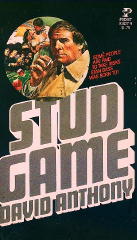
I like mysteries that have titles with two meanings, but believe it or not, this one has three! (1) Stan Bass, who for a friend undertakes a job normally performed by private detectives, is in his own words by profession a gambler. The book opens with an impressive bit of bluff-calling that closes out a “friendly” game of poker. (2) The dead man with a solidly satisfying marriage to a wife in San Francisco is not totally immune to playing a role with the starlet beauties of Los Angeles. (3) One of the starlets gets pregnant on cue, and she calls upon the widow for assistance.
A long and complicated detective story develops, but I fear that at 256 pages, it’s too much of the former for its own good. The plot mixes the usual ingredients with some freshness; the writing is only adequate.
– From The MYSTERY FANcier, Vol. 3, No. 3, May-June 1979.
[UPDATE] 04-29-09. For what it’s worth, and I’d say quite a bit, Kevin Burton Smith thinks that Sam Bass was close enough to being a private eye as to include him on his Thrilling Detective website. Bass only had two recorded adventures, this one and another one.
I wish I remembered more about this book, but other than what I wrote 30 years ago, I’m drawing a complete blank. You know as much as I do, in other words. Regarding my opinion of this book that it’s only about average, there are two big reasons why I think I ought to read it again, if I had the chance. See the next post.
You’ll find a complete bibliography for David Anthony there, too.
Tue 28 Apr 2009
CAPTAIN APPLEJACK. Warner Brothers, 1931. Mary Brian, John Halliday, Kay Strozzi, Alec B. Francis, Louise Closser Hale. Based on the play of the same title by Walter C. Hackett. Director: Hobart Henley.
As a play, Captain Applejack opened on Broadway at the Cort Theatre on December 30, 1921, and ran for 195 performances.
The story was soon thereafter the basis for a silent film, although why they changed the name to Strangers of the Night (Louis B. Meyer, 1923) I do not know. The main players in the cast were Matt Moore as Ambrose Applejohn, Enid Bennett as his ward Poppy, and Barbara La Marr as the vampish Anna Valeska, who in one evening gives Ambrose the thrill of several lifetimes.
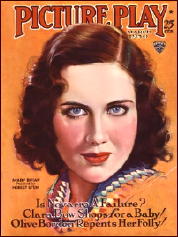
None of the actors’ names in the paragraph above mean anything to me, I apologize for saying, and in fact, the first three names I’ve listed for this 1931 sound remake meant just about as little when I started watching this movie last night. I’ll get back to them shortly.
It’s one of those old British mansion movies, built upon the edge of the cliff – the mansion, that is – and the one night that the owner Ambrose Applejohn (John Halliday) will remember forever is a dark and stormy one.
It begins with Ambrose telling his Aunt Agatha (Louise Closser Hale) and his ward Poppy (Mary Brian) that he’s selling the house and striking out on a tour of the world on a quest for adventure and excitement.
Little does he know … there’s a knock on the door. Enter the beautifully exotic Madame Anna Valeska (Kay Strozzi), seeking not only shelter from the storm, but from the villain of the piece, a chap by the name of Ivan Borolsky. Adventure has fallen into Ambrose’s lap, and he doesn’t even have to leave home.

Of course he is neither as brave and stalwart as he says he is, or would like to be, and if I haven’t told you that this is a comedy, I am right now, and even alone in the room I was in, I laughed out loud several times.
Any movie with a butler named Lush (Alec B. Francis) has to be a comedy, wouldn’t you agree? Nor is Madame Valeska the only one to knock on the door. Soon there is a whole household full of guests, some welcome, some not. Did I mention that Polly is jealous of Madame Valeska? I have now.
Without telling you more than I should, there is a reason for all of the guests and intruders, and the reason has to do with the fact that Ambrose Applejohn is a direct descendant of a cruel pirate named Captain Applejack. There is also a map of sorts.
This is a very entertaining film, albeit noticeably stagey, with a bit of advice that anyone younger than 40 or 50 will probably be bored to abstract fidgetry. That this is a pre-Code film should also be mentioned, with blouses cut lower than they might have been a few years later, and a pair of male hands that do not always stay out of bounds where they belong.
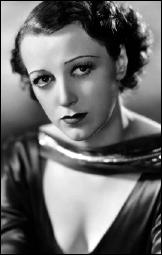
The photo of John Halliday may have come from the film. If not, it’s very close. His career extended from 1911 to 1941, with perhaps his best-remembered role being that of Katharine Hepburn’s father in The Philadelphia Story (1940).
Mary Brian’s wholesome good looks once graced the cover of Picture Play, as you’ve already seen somewhere up above. She started her film-making days playing Wendy Darling in a 1924 silent version of Peter Pan; her final performances were as Corliss Archer’s mother in the 1954 TV sitcom series.
As for Kay Strozzi, in spite of her beautifully exotic appearance (early 1930s style), she made only one other movie, a Bette Davis film called Ex-Wife (1933). Otherwise she seems to have been a Broadway performer, which I can understand, and a soap opera star on the radio, which I don’t.
Tue 28 Apr 2009
Posted by Steve under
Reviews[3] Comments
JAMES M. CAIN – Love’s Lovely Counterfeit.
Vintage, paperback reprint; 1st pr., 1979. First edition: Alfred A. Knopf, 1942. Other paperback reprints include: Avon Murder Monthly 44, 1947; Signet 1445, 1957.
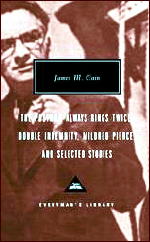
The brief biography of Cain at the end of the book I read, published in 1979, describes him as being “recognized today as one of the masters of the hard-boiled school of American novels.” It’s almost 25 years later, and wondering if that were still true, I decided to see how many of his books are still in print.
Thanks to the folks at Black Lizard, among others, I can report that you can buy any or all of the following novels in new, currently available editions: Mildred Pierce, The Postman Always Rings Twice, Double Indemnity, and The Magician’s Wife. And that’s it. Next month [April 2003] Everyman’s Library is coming out with a omnibus edition (matching their Raymond Chandler books) containing the same first three of the four novels above, plus five short stories.
It’s a must have, but there should be more. The rest of his work seems to have disappeared, including the one at hand. Cain’s reputation seems to have boiled down to only the three novels, plus word of mouth among collectors of vintage paper.
[INSERT] 04-28-09. I’ve just checked online, and unless I’ve missed something, nothing has changed since I first wrote this review.
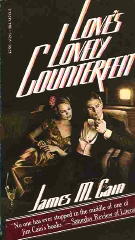
So it’s like this: If you’re a fan of tough guy novels and you ever find a used copy of Love’s Lovely Counterfeit, grab it up.
It’s the story of Ben Grace, a small-time chiseler in the rackets — not crooked, not straight, just in between — who, full of grievances, makes the most of his inside information as Sol Caspar’s chauffeur to aid and abet the opposing party’s upcoming mayoral election campaign. His ally (and soon-to-be lover) in the enemy camp is a very good-looking girl named June Lyons, who is also very dedicated to justice.
It sounds predictable, but it Cain’s hands, it’s anything but. It may seem strange to say, but works of fiction are usually less complicated than the real world, as who would believe the twists and turns that real life can have? But when you think the story’s going one way, Cain heads it off in another. Or, perhaps, he lets it go off in another, on its own, as if he set the characters up, and then he let them find their own destiny, their own fate. Which, of course, they do.
As a footnote, Cain often has a unique touch in the way he describes people. From page 87:
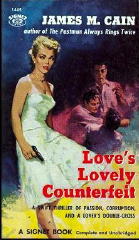
“In [Inspector Cantrell’s] manufacture, one would say that God had started with the feet, shaping them delicately; then proceeded to the body, making it strong and at the same time supple, not too large and not too small; then reached the head as the whistle blew for lunch. It was a round, bulletlike head, on the front of which a face had indeed been moulded, but a face hastily conceived, whose component parts didn’t noticeably match; the heavy jaw was out of kilter with the narrow, low forehead; the right side was seamy, the left side not; it was even somewhat out of plumb, skewing off at an angle in a baffling way. Yet its dark mahogany color gave a startling, sharklike vividness to the light blue eyes, so that while one might instinctively avoid Mr. Cantrell, one would hardly trifle with him.”
Or, this description of June Lyons, as she appears later in the book (page 111):
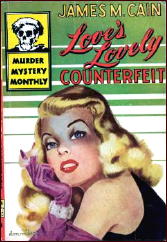
“She too had changed since that night a few months ago when she had made the speech at the high school auditorium, and a man had made a note in a little red book. The neat, school-teacherish blue silk had given way to a smart black polka-dot, with belt, bag, and shoes of coral alligator skin, hat of red straw, and stockings of powdery sheer that set off an exciting pair of legs. It all combined beautifully with her dark creamy good looks, and it seemed that perhaps she knew it. She came in with languid hauteur, or at least the imitation of languid hauteur; it might be recent, but it was innocent.”
I didn’t write either of these two passages. All I did was type them. It only makes me wish I could write.
Mon 27 Apr 2009
SABOTAGE AGENT. MGM-UK, 1943. Aka The Adventures of Tartu. Robert Donat, Valerie Hobson, Walter Rilla, Glynis Johns, Phyllis Morris, Martin Miller. Director: Harold S. Bucquet.
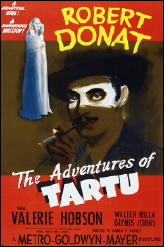
The title of this movie is so generic that when I taped this from the TCM channel last week, I didn’t know that this is the one I was taping. I had, in fact, never heard of Sabotage Agent before, that Robert Donat was in it didn’t register with me, and except for the title, I had no idea what it was about. Which stretches the truth a little, if not a lot, because what the movie’s about, the title says it all.
But with all that as a lead-in, I have to tell you that watching the movie last night was both a pleasure as well as a surprise — even while fully realizing its built-in limitations and how high a rating I could honestly give it. I’ll get back to this in a minute; let me tell you about some of the pluses first.
It’s a propaganda film for the British home front, that seems obvious, but how stirring it must have been to see one man, a British officer (Robert Donat as Captain Terence Stevenson), disguise himself as a Romanian long enough to infiltrate the Nazi occupation force in Czechoslovakia long enough to blow up a chemical plant that was in the process of building a deadly arsenal of poison gas about to be delivered to England in the next wave of bombs to be dropped?
If you were to say “whew” to that last sentence, then deservedly so, as neither does the story in Sabotage Agent allow the viewer to sit back and recognize all of the flaws of the plot, and how unlikely it all is, as it roars on by.
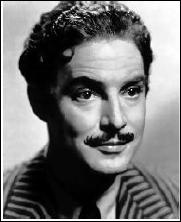
Donat, who won an Oscar as “Mr. Chips,” wasn’t about to win another one for this film, but he manages to stay balanced on a keen edge between being charming and sincere and ostentatiously flamboyant, only to turn visibly discouraged and disheartened at seeing the excesses (and sheer brutality) of the Nazi rule.
If his career hadn’t been suppressed by his own frailties (asthma), I think he could have been his generation’s equivalent of Charlie Chaplin.
Valerie Hobson plays a Czech woman who finds life with the Nazis is far more palatable by fraternizing openly with them, a game that Donat soon sees through, but making contact with the entire Czech underground proves more of a challenge. A young Glynis Johns probably hardened many a British heart against the Nazis, as her character shows what patriotism is all about.
Unfortunately for the film, Captain Stevenson’s job is made all the easier by the sheer stupidity of the Nazi occupiers, both in the particular and in general, as overall strategists. That plus the fact that none of them seem to be able to shoot straight, in a ending straight out of the B-western or Saturday serial genre, keeps this film from being better known than it is, a curiosity out of the dark days of World War II.
Mon 27 Apr 2009
WILLIAM MURRAY – I’m Getting Killed Right Here.
Bantam; reprint paperback, July 1992. Hardcover edition: Doubleday, November 1991.
You may already know this, but William Murray, author of the Shifty Lou Anderson books, of which this is one, died in 2005 at the age of 78. He wrote nine in the series,and even though this is the first one I’ve read, it will not be the last.
Shifty, who tells the stories himself, is what you might call a “close up magician” by vocation and a steady habitue or patron of the racetracks by avocation. Here, first of all, is a list of the nine Shifty Lou Anderson novels:
Tip on a Dead Crab. Viking Press, hc, April 1984.
Penguin, pb, 1985.
The Hard Knocker’s Luck. Viking Press, hc, October 1985.
Penguin, pb, July 1986.
When the Fat Man Sings. Bantam, hc, September 1987.
Bantam, pb, June 1988.
Bantam, pb, June 1990.
The King of the Nightcap. Bantam, hc, July 1989.
Bantam, pb, July 1990.
The Getaway Blues. Bantam, hc, August 1990.
Bantam, pb, May 1991.
I’m Getting Killed Right Here. Doubleday, hc, November 1991.
Bantam, pb, July 1992.
We’re Off to See the Killer. Doubleday, hc, September 1993.
No paperback edition.
Now You See Her, Now You Don’t. Henry Holt & Co., hc, October 1994.
No paperback edition.
A Fine Italian Hand. M. Evans & Co., hc, May 1996.
No paperback edition.
This list does not constitute all of his mystery fiction. Here’s the rest, all but the last appearing before the first Shifty Lou book:
Passport to Terror. Avon T-423, pbo, 1960, as by Max Daniels.
“Love me tonight,” she whispered. “Tomorrow you’ll spit on my grave.”
The Sweet Ride. New American Library, 1967. Signet, pb, 1967.
A novel of the restless generation, the young people who are rebels against authority and accepted conventions – a new breed of youth, the rootless, purposeless ones who want nothing more than a “sweet ride” on drinks, drugs, and sex – but mostly on the ever pounding beckoning surf. [Stated as being only marginally crime fiction in Crime Fiction IV.]
The Killing Touch. Dutton, hc, 1974. [No paperback edition.]
This taut, fast paced novel is not just about an isolated killing, but, more important, about some of the many ways man and women kill each other – through illusion, deceit, even simple neglect.
The Mouth of the Wolf. Little Brown, hc,1977. [No paperback edition.]
A millionaire’s grandson brutally snatched from the streets of Rome.
The Myrmidon Project. Coward, McCann & Geoghegan, hc, 1981, with Chuck Scarborough. Ace, pb, 1982.
A highly rated TV newsman about to retire is hit by a series of personal tragedies, perhaps at the instigation of the chairman of his network.
Dead Heat. Eclipse Press, hc, Sept 2005. [Published posthumously.]
A female jockey searches out a crusty old trainer to help take her to the top.
This does not include any non-crime-related fiction, if any, nor have I attempted to list his non-fiction. Among the latter, however, and not surprisingly, is one entitled The Right Horse: Winning More, Losing Less, and Having a Great Time at the Racetrack. (Never having been to a racetrack, I assume that I am correct in assuming that this is non-fiction.)
From an online tribute to Murray by Robert Cancel comes the following information:
For many years he taught writing as a visiting lecturer at both the University of California, San Diego, and at San Diego State, mostly in the 1980s. His broad interests included opera and Italian literature, resulting in (among other work) two volumes of translations of Pirandello’s work. (In the late 1980s, Murray also wrote the “Letter From Italy” column for
The New Yorker magazine.)
Many of the Shifty Lou Anderson characters and venues were based around tracks in southern California, particularly Del Mar, often framed “in imagery reminiscent of Damon Runyon.” One mystery novel managed to combine two of Murray’s passions, When Fat Man Sings, which is “set in the worlds of horse-racing and opera, with a protagonist reminiscent of Pavarotti, but with a gambling problem.”
What’s at the center of I’m Getting Killed Right Here – which is also the punch line of a joke told on page 166, sort of – is that for the first time, Shifty is an insider at the racetrack.
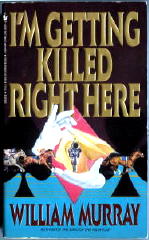
He owns a horse, one that is possibly going to be a very good race horse, but as Charlie Pickard, Mad Margaret’s trainer, reminds him of very early on, don’t count on anything. There are ten thousand ways to lose a race.
Unable to feed and maintain a horse on his own on a magician’s less-than-reliable salary, Shifty needs to take on a partner, and in this case it’s a guy who turns out to have made millions in the construction business, and who also (not so incidentally) has a wife who is a looker (the general consensus) and who is also much younger than he is.
It may not take more than a nudge from me for you to know where this is going right now. It certainly didn’t take very long for me. One brief motel scene later – well, OK, I guess that was more than a nudge, wasn’t it? – Shifty’s new partner knows what has transpires, and he, Shifty, not to mention Linda, is in a good deal of trouble.
Here’s a quickie description of the sort of business problems Shifty’s new partner is having, quoting from page 55:
“… something along the lines of bidding on a job, corrupting the officials in charge of awarding the contracts, kicking back under the table, greasing politicians and bureaucrats, socking the city on cost overruns, padding payrolls, working sweetheart deals with building unions, buying off inspectors, that sort of thing.
“Nothing major,” Arnie added, “just the healthy American pursuit of a buck. I love free enterprise, don’t you? I wonder when somebody’s going to try it.”
Shifty is in over his head, and he damned well knows it. And yet, while this particular escapade on Shifty’s part starts out in rip-roaring old-fashioned Gold Medal fashion, Murray allowed this mammoth sense of impending disaster to be brushed off far too easily, and a the story heads off instead in a modified, somewhat more dignified, and — unfortunately — far more predictable fashion.
Which is not to say that the Gold Medal type of story was not predictable. You know: the one in which the guy gets caught making love to another’s guy younger and good-looking wife, when the second guy belongs to the mob and has connections.
Mr. Cameron, that’s the partner, is a villain through and through, of that there’s no doubt, so don’t get me wrong, but there is another villain behind him and while attempts are made along these lines to keep his role secret, there simply are no doubts at any time about who he is. (This is one of those books in which as soon as the Bad Guy makes his appearance, you know, somehow deep inside, that he is the Bad Guy.)
A detective story this is not, in other words, which to some minds (mine) may leave the ending in something of an anti-climactic nature, but on occasion I am of a forgiving nature, and this is one of them. Shifty’s buddies (Damon Runyonesque, the lot of them) will be around in his next adventure, as will (I imagine) Mad Margaret.
On the other hand, whether his new lady friend appears again is another question altogether. It is to wonder, but my cap is off to Shifty Lou Anderson – there are simply no two ways about it.
Sun 26 Apr 2009
Posted by Steve under
Reviews[2] Comments
A REVIEW BY MARY REED:
LOUIS TRACY – Number Seventeen.
Cassell, UK, hardcover, 1916; Clode, US, hardcover, 1919. Silent film: Fox, 1920 (scw & dir: George A. Beranger).
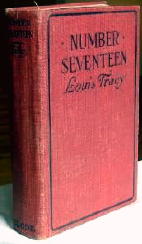
When writer Frank Theydon emerges from a theatre, he notices a beautiful girl and a distinguished man who is evidently her father waiting for their car. A minor accident delays Theydon’s taxi home to Innesmore Mansions by ten minutes, and he notices the man, who had told his daughter he was dropping in at his club, outside the building.
Theydon occupies Flat 18 on the top floor, opposite the titular 17. Much to his surprise the man enters the building. By the sound of his footsteps Theydon deduces the stranger visits 17, the home of Edith, widow of Arthur Lester, for about five minutes, and then leaves.
Next day Theydon is off to dine with millionaire James Creighton Forbes to talk about the latter’s campaign urging the peaceful use of airships. Not long before this engagement Theydon learns Mrs Lester was murdered the previous night. Yet another shock awaits him: Forbes turns out to be the man he saw enter the block of flats. And what’s more, Theydon is followed home from Forbes’ house by a mysterious grey limousine.
After being interviewed that evening by Chief Inspector James Leander Winter and Detective Inspector Charles Furneaux, an unlikely pair who appear to be constantly at each other’s throats but are *far* shrewder than they seem, Theydon becomes involved willy nilly in their investigation of the murder and its ramifications.
And so the reader is off to the races with numerous twists and turns involving, among other things, an American tourist, a motorcycle chase, kidnappings, shots through windows, pea-sized ivory skulls — and the return of the grey limousine.
My verdict: Number Seventeen might best be characterised as a mystery-thriller with a dash of romance. I liked the sparring police partners, straightforward Winter and imaginative Furneaux, who pop up unexpectedly all over the landscape.
There’s plenty of action and a bit of suspense and in fact as Furneaux remarks at one point, “Oh, it’s a plot and a half, I can assure you”, and indeed it is, Oscar, it is.
Etext: http://www.gutenberg.org/dirs/etext04/num1710.txt
Next Page »







